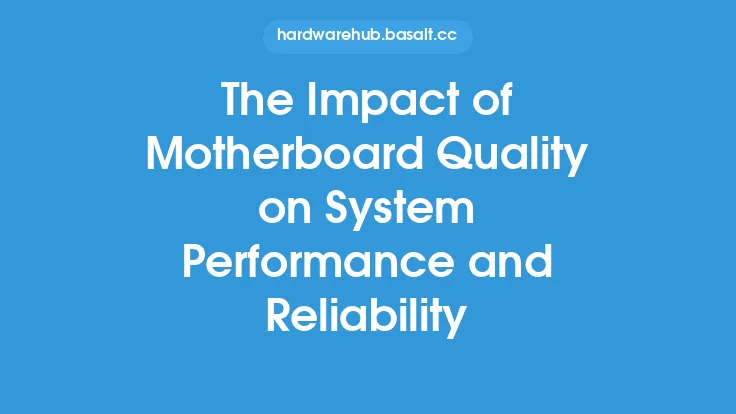When it comes to building a high-performance computer, the motherboard is often considered the backbone of the system. It connects all the hardware components together, allowing them to communicate and function in harmony. High-end motherboards, in particular, are designed to provide exceptional performance, stability, and features that cater to the needs of enthusiasts, gamers, and content creators. In this article, we will delve into the impact of high-end motherboards on system performance and stability, exploring the various aspects that make them an essential component of a high-performance computer.
Introduction to High-End Motherboards
High-end motherboards are designed to offer superior performance, reliability, and features compared to their mid-range and budget counterparts. They are built with high-quality components, such as solid capacitors, high-efficiency voltage regulators, and advanced cooling systems, which enable them to handle demanding workloads and extreme overclocking. These motherboards often feature advanced chipsets, multiple PCIe lanes, and high-speed storage options, making them ideal for applications that require intense processing power, high-speed data transfer, and low latency.
Impact on System Performance
High-end motherboards have a significant impact on system performance, thanks to their advanced features and high-quality components. One of the primary advantages of high-end motherboards is their ability to handle high-speed memory and storage devices. For example, many high-end motherboards support DDR4 memory with speeds of up to 3200MHz or more, which provides a significant boost to system performance. Additionally, high-end motherboards often feature multiple PCIe lanes, which enable the use of high-speed storage devices such as NVMe SSDs, graphics cards, and networking cards. These features combined provide a significant increase in system performance, making them ideal for applications such as gaming, video editing, and 3D modeling.
Power Delivery and Voltage Regulation
Power delivery and voltage regulation are critical aspects of high-end motherboards, as they directly impact system stability and performance. High-end motherboards often feature advanced power delivery systems, such as digital voltage regulators, which provide precise control over voltage and current delivery to the CPU and other components. This enables the system to operate at optimal levels, reducing the risk of overheating, instability, and component damage. Additionally, high-end motherboards often feature advanced cooling systems, such as heat sinks and fan headers, which help to dissipate heat generated by the power delivery system, ensuring stable operation even under extreme loads.
Overclocking and Tuning
High-end motherboards are designed to cater to the needs of enthusiasts and overclockers, providing a range of features and tools to help optimize system performance. Many high-end motherboards feature advanced overclocking tools, such as BIOS settings, software utilities, and hardware buttons, which enable users to fine-tune their system's performance. These tools allow users to adjust settings such as CPU multiplier, voltage, and memory timings, enabling them to push their system to its limits. Additionally, high-end motherboards often feature advanced monitoring and diagnostic tools, which provide detailed information on system performance, temperature, and voltage, helping users to identify and optimize their system's performance.
Stability and Reliability
High-end motherboards are designed to provide exceptional stability and reliability, thanks to their high-quality components and advanced features. One of the primary advantages of high-end motherboards is their ability to handle extreme temperatures and voltage fluctuations, which can cause instability and component damage in lower-end motherboards. High-end motherboards often feature advanced cooling systems, such as heat sinks and fan headers, which help to dissipate heat generated by the system, ensuring stable operation even under extreme loads. Additionally, high-end motherboards often feature advanced protection mechanisms, such as overvoltage protection, undervoltage protection, and short-circuit protection, which help to prevent component damage and ensure system stability.
Conclusion
In conclusion, high-end motherboards have a significant impact on system performance and stability, thanks to their advanced features, high-quality components, and precise engineering. They offer exceptional performance, reliability, and features that cater to the needs of enthusiasts, gamers, and content creators. Whether you're building a gaming PC, a workstation, or a server, a high-end motherboard is an essential component that can help you achieve optimal performance, stability, and reliability. By understanding the impact of high-end motherboards on system performance and stability, you can make informed decisions when building or upgrading your computer, ensuring that you get the most out of your system and enjoy a seamless computing experience.





